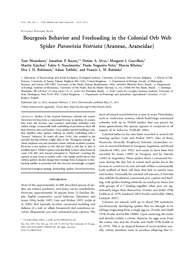Bourgeois behavior and freeloading in the colonial orb web spider Parawixia bistriata (Araneae, Araneidae).
Bourgeois behavior and freeloading in the colonial orb web spider Parawixia bistriata (Araneae, Araneidae).
Author(s): WENSELEERS, T.; BACON, J. P.; ALVES, D. A.; COUVILLON, M. J.; KARCHER, M.; NASCIMENTO, F. S.; NOGUEIRA NETO, P.; RIBEIRO, M. de F.; ROBINSON, E. J. H.; TOFILSKI, A.; RATNIEKS, F. W.
Summary: Spiders of the tropical American colonial orb weaver Parawixia bistriata form a communal bivouac in daytime. At sunset, they leave the bivouac and construct individual, defended webs within a large, communally built scaffolding of permanent, thick silk lines between trees and bushes. Once spiders started building a web, they repelled other spiders walking on nearby scaffolding with a bounce behavior. In nearly all cases (93%), this resulted in the intruder leaving without a fight, akin to the bourgeois strategy, in which residents win and intruders retreat without escalated contests. However, a few spiders (6.5%) did not build a web due to lack of available space.Webless spiders were less likely to leave when bounced (only 42% left) and instead attempted to freeload, awaiting the capture of prey items in nearby webs. Our simple model shows that webless spiders should change their strategy from bourgeois to freeloading satellite as potential web sites become increasingly occupied.
Publication year: 2013
Types of publication: Journal article
Unit: Embrapa Semi-arid Region
Keywords: Colônia, Ecologia, Ecologia e sociabilidade, Ecology, Parawixia bistriata
Observation
Some of Embrapa's publications are published as ePub files. To read them, use or download one of the following free software options to your computer or mobile device. Android: Google Play Books; IOS: iBooks; Windows and Linux: Calibre.
Access other publications
Access the Agricultural Research Database (BDPA) to consult Embrapa's full library collection and records.
Visit Embrapa Bookstore to purchase books and other publications sold by Embrapa.

